
An aerial view of the Spallation Neutron Source on Chestnut Ridge at Oak Ridge National Laboratory. (Photo by ORNL)
Note: This story was updated at 10:15 a.m. Aug. 1.
Oak Ridge National Laboratory is pursuing two major upgrades to its Spallation Neutron Source that would allow new scientific research and could cost more than $1 billion.
The two proposed upgrades are a proton power upgrade and a second target station. The two projects are in different stages of review at the U.S. Department of Energy, ORNL spokesperson Morgan McCorkle said.
The proton power upgrade, or PPU, is being pursued first, and its current cost estimate is a little more than $200 million, McCorkle said. If approved, it would double the power of SNS’s proton beam from 1.4 megawatts to 2.8 megawatts.
The upgrade would allow new types of research at SNS, and it would increase the number of scientists who can use the facility each year, McCorkle said.
“The PPU will enable experiments that are not currently feasible, such as experiments on smaller or less concentrated samples, and experiments under more extreme environmental conditions,” McCorkle said. “The new scientific capabilities will support research in areas such as soft matter, quantum materials, chemistry, functional materials, and biology. Some examples of everyday products that may be improved by these discoveries include cell phones, batteries, computers, building materials, and drugs.”
The proton power upgrade would also eventually provide the extra power necessary for the proposed second target station, or STS. The design of the second target station is less mature, but the project could cost in the range of $1 billion and include about 300,000 square feet of new buildings, McCorkle said. The second target station would be on the east end of the SNS campus on Chestnut Ridge at ORNL.
The original SNS master plan supported two target stations along with power upgrades to the existing accelerator, according to a January 2015 technical design report.
The Spallation Neutron Source cost $1.4 billion, and it started operating in 2006. It provides the most intense pulsed neutron beams in the world for scientific research and industrial development.
It’s one of two neutron sources at ORNL. The other is the High Flux Isotope Reactor, or HFIR. The second target station at SNS would be a third.
The SNS includes experiment stations that can be used by researchers in a range of disciplines that include physics, chemistry, materials science, and biology. There are currently 19 instruments, DOE said in a budget request submitted to Congress in May.
McCorkle said it’s not possible to give start times and estimated completion times for the SNS upgrades until the U.S. Department of Energy approves the proposals and sets a construction timeline based upon available resources.
There was some funding recommended for the first project, the proton power upgrade, in an energy and water appropriations bill approved by the Senate Appropriations Committee on Thursday, July 20. If approved, the federal funding of $26 million recommended in that bill would be used for preliminary engineering and design of the proton power upgrade, and to “continue work towards a project baseline” in fiscal year 2018, which starts October 1. (See page 88 here.) It’s not clear when the legislation might be considered by the full Senate.
But neither the House nor the Trump administration appear to have included funding in the next fiscal year for either SNS upgrade, at least not so far. The House Appropriations Committee did approve an energy and water appropriations bill this month, but that legislation didn’t appear to specifically cite funding for the proton power upgrade or mention the second target station, according to this House report.
The budget request submitted to Congress by President Donald Trump on Tuesday, May 23, proposed a 10 percent cut, compared to fiscal year 2016, for SNS and HFIR. There would be reduced hours and user support, and “selected flight paths will be shut down,” according to the Trump administration’s budget request. Maintenance, upgrades, and procurement activities would be deferred. (See pages 49-50, 82, and 93 here.)
“The funding decrease will support below optimal operations for HFIR and SNS,” the president’s budget request said.
No funding was requested for the second target station at SNS, the request said.
But so far, major components of the president’s budget request—including a proposed funding cut of $919 million to DOE’s Office of Science—have been rejected by members of both parties who are members of appropriations committees in both the House and Senate. SNS and HFIR are both supported by the U.S Department of Energy’s Basic Energy Sciences program, and Basic Energy Sciences is part of the DOE Office of Science. Also, ORNL is an Office of Science lab.
The House Appropriations Committee recommended keeping Office of Science funding flat, while the Senate Appropriations Committee recommended increasing the funding to another record level.
It’s not clear what the final funding levels will be for SNS and its planned upgrades.

The proposed new buildings for the second target station on the east end of the Spallation Neutron Source campus on Chestnut Ridge at Oak Ridge National Laboratory. (Image by ORNL)
ORNL has said that neutron scattering is an essential technique for advancing materials research that supports the U.S. economy and provides solutions to challenges in energy, security, and transportation. It’s useful to scientists because it is one of the few characterization techniques that reveals where atoms are and how they move. That helps researchers understand the relationships between the structure, dynamics, and function of materials, from batteries and superconductors to polymers and enzymes. This understanding allows researchers to form predictive models that inform new material designs, ORNL said.
“It (neutron scattering) provides information that cannot be determined using any other research method,” the lab said in an overview of the proposed second target station at ORNL.
The second target station at SNS will fill in gaps in materials research that require the combined use of intense, cold (longer wavelength) neutrons and instruments that are optimized for the exploration of complex materials, ORNL said.
SNS generates neutrons by propelling protons down a linear accelerator. When the protons collide with a liquid mercury target, they create a “spall” of neutrons that are corralled into beam lines linked to surrounding research instruments, according to ORNL. More than 1,800 researchers used these neutrons in 2016 to reveal details about the nature and characteristics of materials used in medicine, energy, technology, and industry
The second target station would use a smaller tungsten target and produce neutrons in a much smaller volume than those reaching the first SNS target, the mercury target. The second target is expected to support 22 instruments that will be selected with input from scientists.
The project work is expected to include upgrades to the existing SNS accelerator to support the second target station. The second station will receive 10 proton pulses per second, while the existing target station will receive 50 pulses per second, according to the January 2015 technical report. A 60-hertz pulse stream is currently delivered to the first target station.
The liquid mercury in the present stationary target doubles as both the spallation material and the coolant. The target in the second station would be solid tungsten, but the target would rotate and be cooled by water. The latest plan calls for a proton beam of about 700 kilowatts at the second target station.
The second target station project could include about 380,000 square feet of new construction, mostly on a 12-acre site, and support about 300 permanent staff and visiting users, the technical report said. The Chestnut Ridge campus would then include about 1.1 million square feet of space and roughly 900 people.
ORNL has said the second target station will emphasize the production of long wave neutrons, which are predominantly used for soft materials and complex materials, and will address complexity as a unifying science theme.
Among the opportunities that researchers have previously cited: the chance to get more neutrons onto smaller samples, and the ability to measure complex materials efficiently and accurately, using a more powerful beam of long wavelength neutrons.
The second target station has been part of SNS plans for many years. A DOE advisory committee recommended in 1996 that SNS be designed to eventually operate at a significantly higher power and include additional target stations. An environmental impact statement in 1999 included a second target station. DOE acknowledged the scientific need for a second target station in 2009, and a DOE advisory committee said in 2013 that the proposed second target station is “absolutely central” to U.S. scientific leadership, although there are significant scientific and engineering challenges to resolve.
As part of the effort to develop the second station, ORNL hosted a user workshop in October 2015, when scientists were able to help “develop the science case” and refine and rank proposed instrument concepts. (See this Second Target Station Workshop Report from October 2015 and see also this Oak Ridge Today story.)
A project management team was formed the next month, in November 2015, and funding was received in January 2016 to kick off the development of a conceptual design.
More information will be added as it becomes available.
Learn more about the proposed second target station at ORNL here: https://neutrons.ornl.gov/sts/.
See a second target station fact sheet here: SNS Second Target Station Fact Sheet February 2016.
See the January 2015 technical design report here.

A site overview showing the second target station at the Spallation Neutron Source at Oak Ridge National Laboratory. (Image by ORNL)
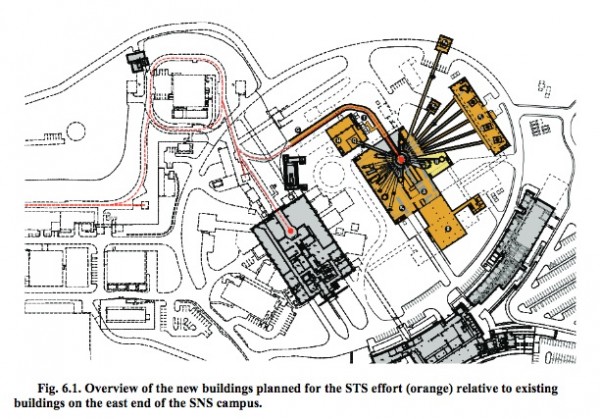
An overview of the new buildings planned for the second target station on the east end of the Spallation Neutron Source campus on Chestnut Ridge at Oak Ridge National Laboratory. (Image by ORNL)
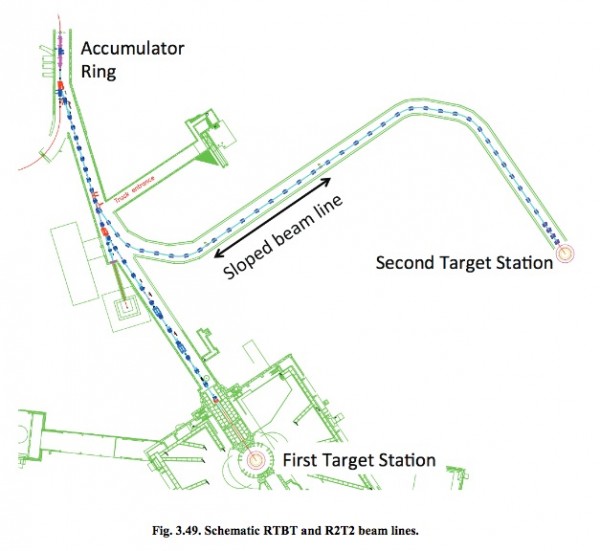
A beam schematic for the first and second target stations at the Spallation Neutron Source at Oak Ridge National Laboratory. (Image by ORNL)

Target systems with the second target station at the Spallation Neutron Source at Oak Ridge National Laboratory are shown above. (Image by ORNL)
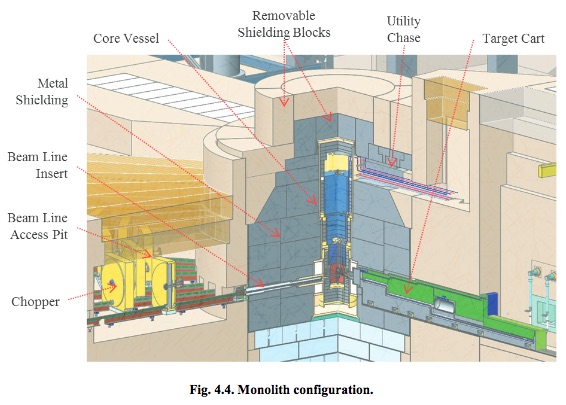
The monolith for the proposed second target station at the Spallation Neutron Source at Oak Ridge National Laboratory will be similar to that used at many accelerator-based spallation sources, and it is where the proton beam will enter horizontally and strike the tungsten target. (Image by ORNL)

An image of the tungsten target at the proposed second target station at the Spallation Neutron Source at Oak Ridge National Laboratory, right, is shown next to an image of the existing mercury target, left. (Image by ORNL)
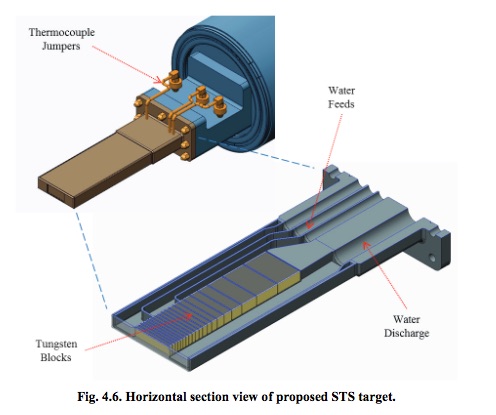
A horizontal view of the proposed water-cooled tungsten target at the proposed second target station at the Spallation Neutron Source at Oak Ridge National Laboratory. (Image by ORNL)
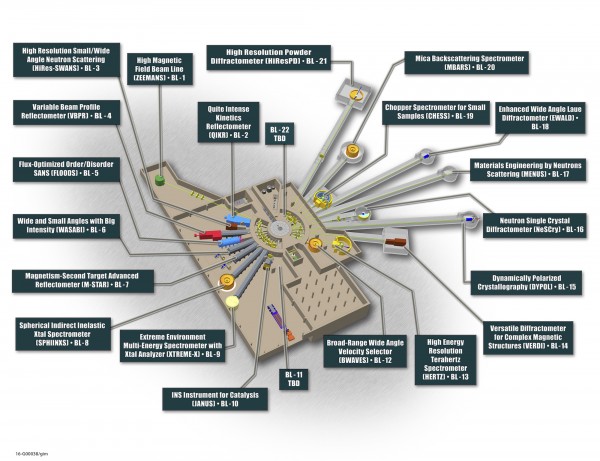
The potential instrument layout at the proposed second target station at the Spallation Neutron Source at Oak Ridge National Laboratory. (Photo by ORNL)
Do you appreciate this story or our work in general? If so, please consider a monthly subscription to Oak Ridge Today. See our Subscribe page here. Thank you for reading Oak Ridge Today.
Copyright 2017 Oak Ridge Today. All rights reserved. This material may not be published, broadcast, rewritten, or redistributed.
Leave a Reply